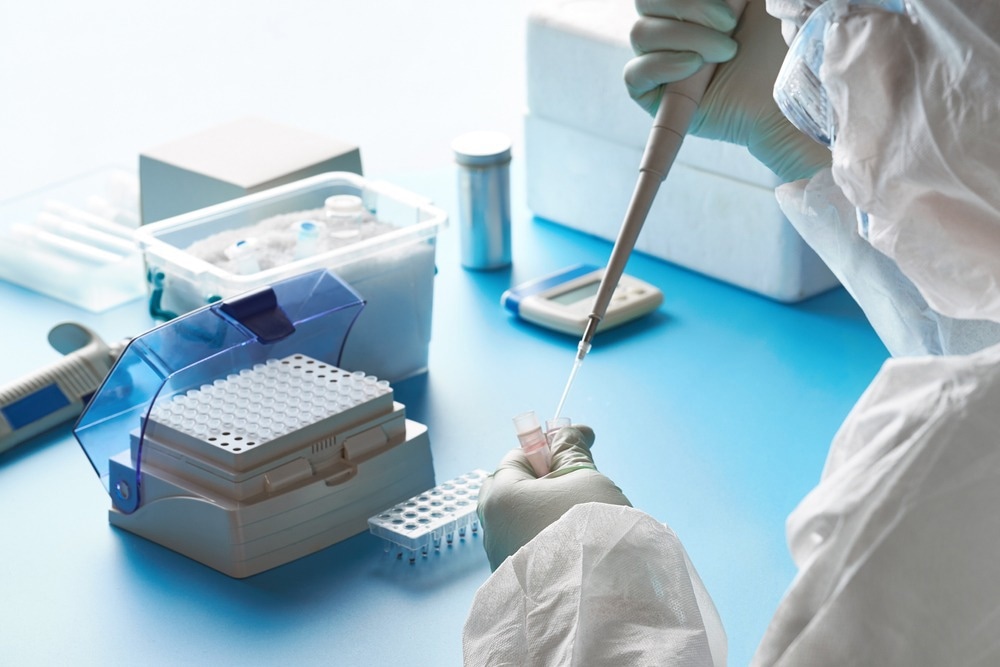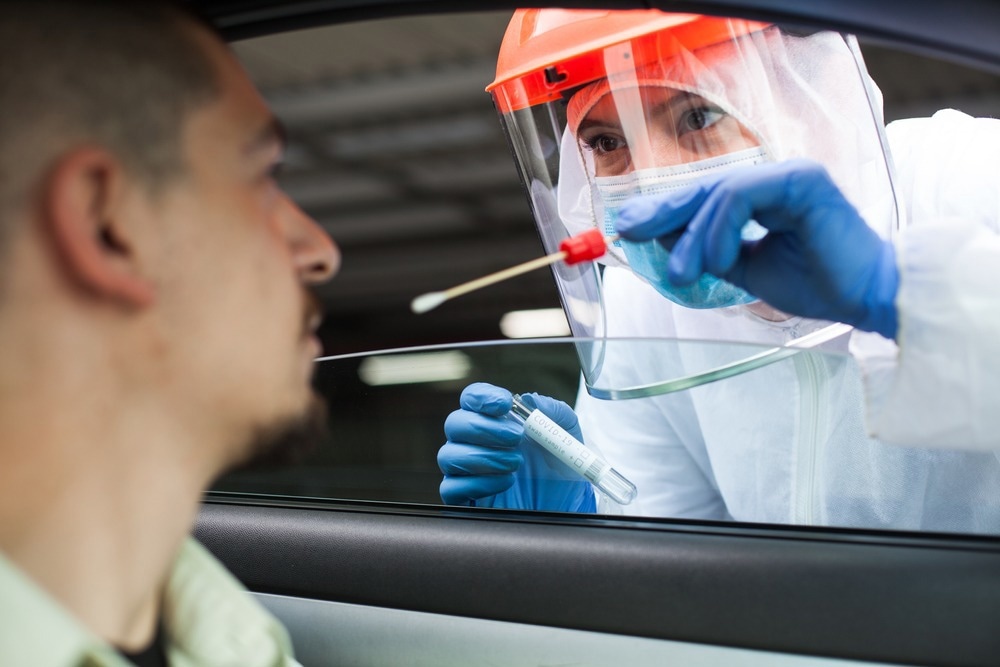The polymerase chain reaction (PCR) technique is popularly used in laboratories and research centers for many applications, such as DNA sequencing, genomic library creation, gene expression profiling, and mutagenesis. PCR is commonly applied in diagnostic, clinical, and forensic science. Over years, many improvements have been made in PCR equipment, which has revolutionized scientific research.

Image Credit: tilialucida/Shutterstock.com
History of PCR
The foundation of PCR was laid in 1953 when James Watson and Francis Crick discovered the double-helix structure of DNA. This discovery highlighted the possibility of copying a mechanism for DNA. Eventually, after the discovery of DNA polymerase, a DNA template could be copied in one direction. Although Kjell Kleppe from Khorana's laboratory proposed a two-primer system, it failed to work because the then available DNA polymerase could not withstand high temperatures.
In 1983, Kary Mullis at the Cetus Corporation first developed PCR technology. Initially, this technique was highly time-consuming, as all steps had to be manually operated. The advancements of PCR were not possible without the evolution of DNA polymerase. In 1976, the thermostable enzyme Taq-polymerase was isolated from the bacterium Thermus aquaticus and this polymerase is still being used in PCR. The incorporation of Taq-polymerase removed the need for adding new doses of enzymes after every thermal cycle, and this paved the way for the development of an automated thermal cycler.
In 1987, the first commercial thermal cycler, i.e., the TC1 DNA Thermal Cycler (TC1), was developed. In 1988, R. Saiki and K. Mullis highlighted the importance of using thermostable Taq-polymerase in TC1. This device was first used to amplify the DNA of ancient human bones in 1989, which escalated the understanding of extinct human ancestors and the evolution of human diseases.
PCR Equipment and its Working
PCR amplifies DNA by copying genomic strands exponentially. The main equipment and products involved in the PCR procedure are a thermal cycler, PCR reagent (e.g., enzymes), deoxynucleotide triphosphates (dNTPs), primers, dyes, and master mixes.
A thermal cycler is also known as a PCR machine or thermocycler, which heats and cools samples in repetitive cycles to facilitate DNA/RNA amplification through PCR. As stated above, this machine is commonly present in most laboratories. The recent introduction of smaller and portable thermal cyclers has enabled its use in classrooms as well. The advancements in thermal cyclers have reduced their operational complexities, for instance, programmable thermal cyclers can save frequently used protocols. High-throughput laboratories use automated PCR instruments.
The PCR master mix consists of six components that include PCR-grade water, which is free of nuclease, inhibitors, and contaminants, and dNTPs (dATP, dCTP, dGTP, and dTTP) to create the complementary DNA copies of target DNA. Both forward and reverse primers are required along with Taq-polymerase and a buffer with a pH between 8.0 and 9.5. Magnesium chloride is also used to enhance the DNA polymerase activity, which aids primers to anneal to the template DNA for a higher amplification rate.
As per PCR protocol, the template DNA, which can be a plasmid DNA (pDNA), genomic DNA (gDNA), or complementary DNA (cDNA), is added to the reaction tube containing the PCR master mix. This reaction tube is placed into the thermal cycler, where it undergoes 20 to 35 cycles comprising two to three temperature steps. It is here where the process of denaturation, annealing, and extension occurs. Subsequently, multiple copies of target DNA are produced.
Although theoretically, the amount of PCR product doubles at every thermal cycle, causing exponential production of target DNA, in reality, this does not happen. The exponential amplification phase ceases and reaches a plateau when all reagents are exhausted and the DNA polymerase activity decreases. After performing the standard PCR reaction, the concentration, purity, and yield of DNA copies are assessed using gel electrophoresis, fluorometry, or spectrophotometry.

Image Credit: nechaevkon/Shutterstock.com
Application of Different Types of PCR
PCR can detect protozoan parasites, bacterial agents, and viral pathogens, such as Plasmodium falciparum (malaria), Bacillus anthracis (anthrax), and human immunodeficiency virus. In addition, this technique is used to analyze cancer patients’ responses to therapy. This instrument is also used to detect genetic disorders, such as sickle cell anemia, muscular dystrophy, albinism, and cystic fibrosis. Over the years, different types of PCR have been developed that have varied applications. Some of the important types of PCR systems are discussed below:
Quantitative PCR (qPCR):
Quantitative PCR is also known as real-time PCR, which is used to study gene expression, methylation analysis, miRNA research, and quantification of target genes. In addition, it is used to detect genomic mutations. qPCR requires a fluorescent intercalating dye or a fluorescently labeled probe and a thermal cycler to measure fluorescence and estimate cycle threshold (Ct) value. Generally, the fluorescence intensity increases in accordance with the concentration of PCR product, which can be measured in real-time.
Reverse Transcription PCR (RT-PCR):
RT-PCR is used to amplify RNA target sequences, such as RNA virus genomes or messenger RNA. In this type of PCR, RNA samples are incubated with a reverse transcriptase enzyme and a DNA primer before PCR amplification. RT-PCR is commonly used to determine changes in gene or chromosomal structure, or activation of specific genes, which help in the diagnosis of various diseases including cancer. When qPCR reaction is performed instead of standard PCR protocol, this type of PCR variant is known as RT-qPCR.
Viability PCR (vPCR):
Standard PCR is unable to distinguish between the DNA of viable and non-viable cells. vPCR is used to investigate whether a pathogenic microbe in clinical samples is viable or not. In this case, the samples are divided into two aliquots, where one is incubated with a photoreactive intercalating dye that cannot diffuse through intact cell membranes of live cells, and the other is left untreated. When the former aliquot is treated with blue light, the dye binds with DNA irreversibly. DNA from both aliquots is purified and subjected to qPCR amplification. Similar qPCR signals from both the aliquots indicate that the target microorganisms in the samples are viable. vPCR is commonly used in agriculture, food safety, and diagnostics.
Digital droplet PCR (ddPCR):
The ddPCR is a relatively new type of PCR that uses fluorescently labeled probes to identify target DNA sequences. This technique uses a water-oil emulsion system to divide each sample into about 20,000 nanoliter-sized droplets. Post the standard PCR amplification step, every droplet is analyzed automatically. Droplets containing at least one target DNA sequence fluoresce. Compared to qPCR, ddPCR is more accurate and suitable for multiplexing assays. ddPCR is used in gene expression studies, allelic discrimination and to detect mutations and SNPs.
Hot Start PCR:
When PCR reaction results in non-specific amplification to increase its specificity, a hot start polymerase is used. To avoid unintentional DNA products, this enzyme remains inactive during master mix preparation and the addition of target DNA.
Nested PCR:
This type of PCR has been developed as an alternative to hot start PCR. It determines the number of errors that occurs during DNA amplification. Two sets of primers and two successive PCRs are involved with nested PCR. The first set of primers amplifies DNA sequences longer than the sequence of interest while the second primers are used for the subsequent PCR reaction to amplify the targeted region. Nested PCR promotes the specificity of DNA amplification.
PCR Demand and Global Manufacturer
The demand for PCR solutions is increasing in many countries, such as India, China, and Japan, due to an increase in diagnostic laboratories and research activities. According to Amber Chourasia, lead laboratory equipment analyst at Technavio, an analytical company based in London, “These countries will constitute the fastest growing market, with many local players having a considerable share in the market due to their low-cost PCR solutions”.
Many big and small start-up companies manufacture different types of PCR equipment. It is important to select the right PCR equipment for a laboratory or classroom, which is based on protocol flexibility, ease of decontamination, downstream applications, required space for installation, and throughput.
Some of the key manufacturers of PCR systems and their related products are Agilent Technologies, QIAGEN, Roche Diagnostics, and Thermo Fisher Scientific. Recently, Bio-Rad Laboratories launched QX200 Droplet Digital PCR System, which is a new digital PCR system that offers absolute quantification of DNA amplification.

Image Credit: Cryptographer/Shutterstock.com
PCR and COVID-19 Pandemic
To restrict the further spread of severe acute respiratory syndrome coronavirus-2 (SARS-CoV-2), the causal agent of the ongoing coronavirus disease 2019 (COVID-19) pandemic, RT-PCR tests were widely conducted to identify and isolate infected persons.
Some of the common PCR machines used for COVID-19 detection are Bio-Rad CFX96 and ABI Applied Biosystem's Quant Studio 3D Digital PCR System and Quant Studio 5. These systems are equipped with analytical software that enables fast and easy use. QIAstat-Dx from Qiagen is fast and highly accurate and was specifically designed to detect the SARS-CoV-2 virus.
Needless to say, due to the COVID-19 outbreak, the PCR industry grew exponentially in 2020 and 2021. However, the PCR market demand could be hampered significantly in the future due to falling number of COVID-19 cases and the fact that a large number of manufacturers have received approval for novel PCR tests.
Sources:
- Merk. (2023) ‘PCR Supplies & Equipment’. Available at: https://www.sigmaaldrich.com/GB/en/products/labware/pcr-supplies-and-equipment. (Accessed: 26 January 2023).
- Promega. (2023) ‘PCR Amplification’. Available at: https://www.promega.co.uk/resources/guides/nucleic-acid-analysis/pcr-amplification/. (Accessed: 26 January 2023).
- Meszaros, E. (2022) ‘The complete guide to PCR’. Available at: www.integra-biosciences.com/.../complete-guide-pcr. (Accessed: 26 January 2023).
- Fortune Business Insights. (2022) Polymerase Chain Reaction (PCR) Market. Available at: https://www.fortunebusinessinsights.com/polymerase-chain-reaction-pcr-market-102528. (Accessed: 27 January 2023).
- Stursberg, S. (2021) ‘Setting up a PCR lab from scratch’. Available at: https://www.integra-biosciences.com/united-kingdom/en/blog/article/setting-pcr-lab-scratch. (Accessed: 26 January 2023).
- Dhar, R. (2020) ‘Top 10 PCR Machines for Covid-19 Patients’. Available at: https://sonoransurplus.com/top-10-pcr-machines/. (Accessed: 27 January 2023).
- Petr, K. and Matteo, R. (2017) ‘A Basic Guide to Real Time PCR in Microbial Diagnostics: Definitions, Parameters, and Everything’. Frontiers in Microbiology. 8. DOI=10.3389/fmicb.2017.00108
- Sigma-Aldrich. ‘PCR Technologies: a Technical Guide’. Available at: www.sigmaaldrich.com/.../pcr-technologies-guide.pdf. (Accessed: 26 January 2023)
Further Reading